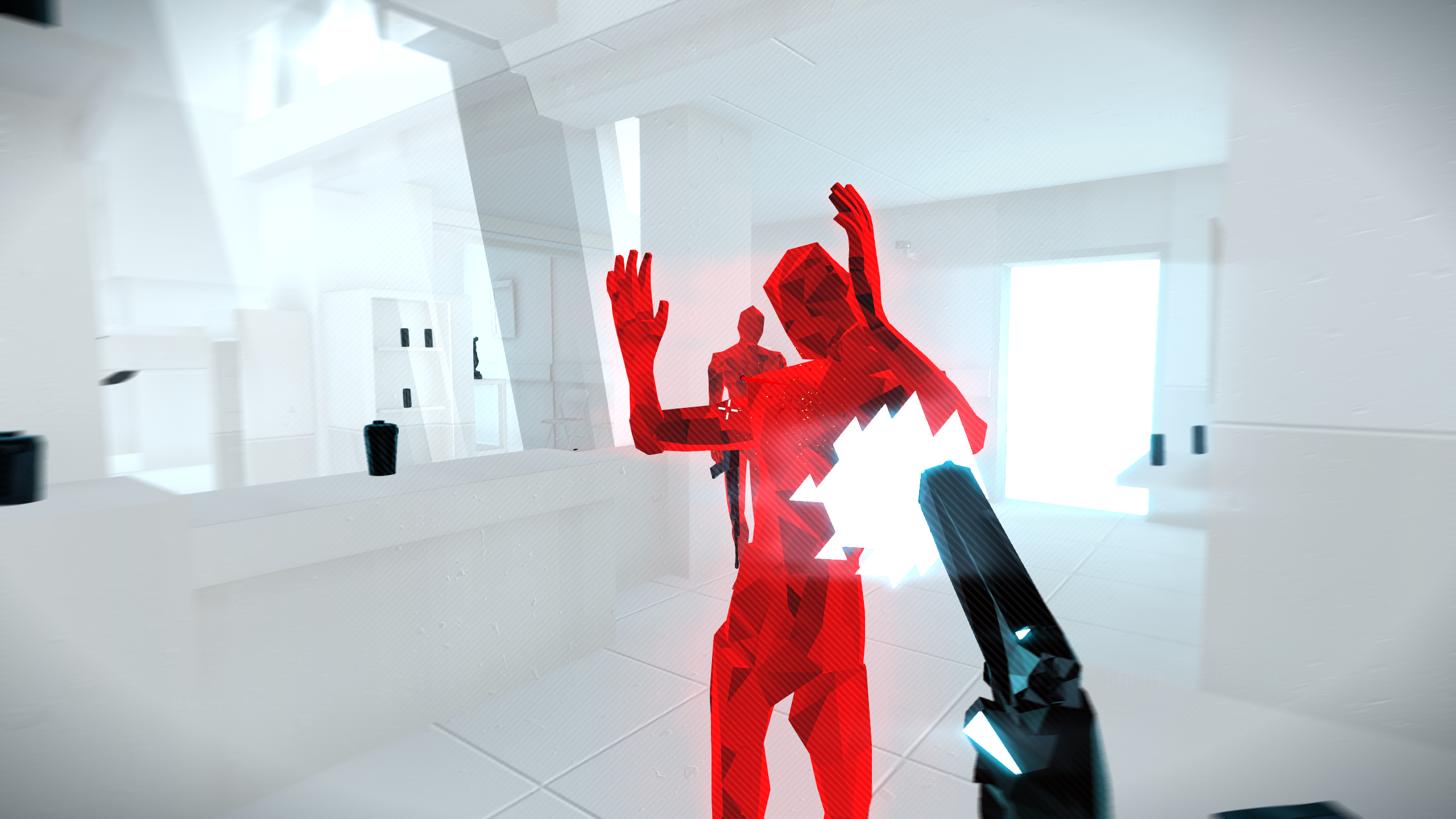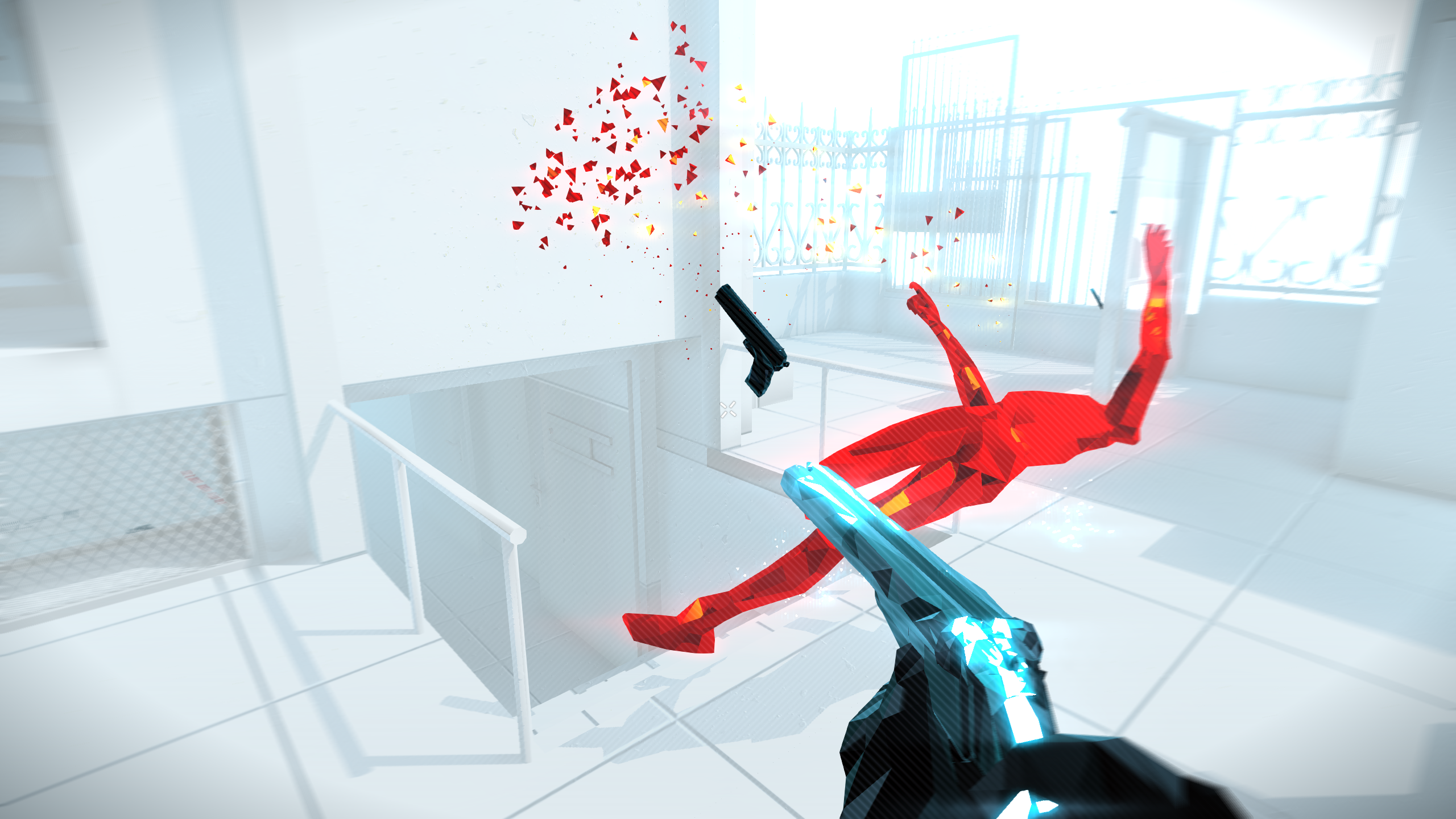
SUPERHOT: MIND CONTROL DELETE PC Review
MIND CONTROL DELETE brings out the best in SUPERHOT. (But if your favourite part of SUPERHOT was its second-best thing, that’s admittedly nowhere to be found here.)

I will not presume to know all the ways a person could love 2016’s phenomenal SUPERHOT – a first person shooter fundamentally redefined by its “time only moves when you move” twist on gameplay – but I know for a fact about two of them. SUPERHOT’s “campaign mode” presented maps built like combat puzzles, where your margins in terms of timing were to be exploited in clever ways to best the scenario at hand.
One of the most illustrative levels in the original is the one called Elevator Pitch, where you start out at gunpoint from three enemies, with no obvious way to avoid being shot by at least one of them. When you realise what you can do to solve your predicament, there’s this a-ha moment that feels like you solved a puzzle. SUPERHOT the puzzle game is not really represented in MIND CONTROL DELETE at all.
The other, deeper, more dynamic aspect of SUPERHOT was the thinking-on-your-feet dance of combat – of reacting spontaneously, improvising perpetually, to keep enemies in check. The Endless mode offered hours and hours of wave based survival that gradually turned up the pressure to the nth degree, providing teeth gritting, butt clenching, fighting-tooth-and-nail gameplay.

Even though the aforementioned combat puzzles were built on top of the same core gameplay, the survival mode exposed just how much more dynamic the game underneath was, in ways you never got to experience if you stopped playing after the somewhat brief campaign.
But, while the campaign arguably ended too soon, the survival mode never ended. Depending on what type of player you are, that could make either mode a non-starter. What MIND CONTROL DELETE does is smush the two together, creating a game that does end eventually, but not too soon. It knows precisely how to lean on the strengths of its astonishing underlying design, and provide a level structure that makes it feel like a survival mode served in portions, with an overarching sense of progress.
You could describe the game as a linear survival game with rogue-like elements, but portioned out in chunks of several maps that you have to survive in one go to move along in the overall game. Each sequence of maps has you selecting a base ability, and then sees you selecting additional, stacking abilities between the maps. The latter are retained until you’ve finished out the sequence, or lost if should you meet your demise and the sequence is reset. It’s a great way to structure the game, and it encourages assembling a different build of character each time you start a new batch of maps.

The abilities themselves – or “hacks” as they’re referred to in the lore – are what truly define MIND CONTROL DELETE. The original game had similar “mutators” that you could unlock and play the game with, but they never saw interplay between themselves. Not only are these an absolute delight to use, they also interact in satisfying ways. A base ability called charge, which has you launching at an opponent from a distance, is suddenly made extra lethal by combining it with the super punch ability, which destroys an enemy in one hit. That is further made even more formidable by a different ability that reduces cool down on your base ability with each kill.
There’s a ricochet ability that sees bullets bounce toward the nearest enemy when they hit a wall, and combined with the piercing shot ability that makes bullets travel through enemies, that means shooting through enemies for the bullets to then bounce toward whoever is left standing. It is fantastic stuff.
There are aspects of MIND CONTROL DELETE that I have thoughts on, good and bad, but I may discuss them at a later time in a sort of post-brief, because it is a purposefully mysterious game, and I want to respect that.

However, I have some issues with more glaring design decisions that rear their head quite early. An issue that lingers for the duration is that while new maps are introduced, every single one is horrifically overused. There’s baffling amounts of repetition that somehow makes aspects of the experience far more samey than either mode present in its predecessor. The new abilities change things up and the core gameplay is always sound, but not only do you play the same levels over and over as part of each sequence, you are also sent back to the beginning of each sequence each time you die. No locale is as exciting as any of the campaign scenarios of SUPERHOT, nor are they as expansive as the survival mode maps of the original game. The map design here is adequate, but decidedly unremarkable, and visually – in terms of geometry of course – downright dull.

New maps do enter the rotation, but they’re drip fed to the point where the fresh breeze they contribute can’t remotely combat the feeling of stagnation, and by the time you’re seeing yet newer maps, they almost epitomise the expression too little too late. Only, over and over in this case. It’s strange, even, considering how simplistic the geography is, that there isn’t an abundance of maps at this point, four years after the first game released. This game even has repeated maps from the first game, and yet the repetition thereof is also pervasive.
It’s also a very slow burn, and some design choices that are immediately off putting aren’t justified until hours have passed, and I can see some people giving up before then. I honestly wouldn’t even blame them. Once it gets going, it’s another astonishing game, but the only reason I ever feel like ending a play session is exclusively because you sure spend a whole lot of time in the exact same maps. Over and over and over. Then there’s a new map, and you’re like “is this a new map?”, and then before long that’s all too familiar, too.

So where do we land on this?
SUPERHOT: MIND CONTROL DELETE is superb. The core of it is even better than its predecessor, in fact, by virtue of identifying how to expand on it in a way that truly makes sense. The new abilities not only slot in beautifully; there’s a sense that they bring out more of what is inherently part of the design. It’s like SUPERHOT created a space (and a time!) to exist in, and MIND CONTROL DELETE is effortlessly (albeit with effort, I’m sure!) finding ways to play in that space. It is a masterclass in what video games can do, by realising they can do anything, freed from the shackles of regular earth logic, but staying true to their own logic in a way that is consistent and immensely satisfying.
It’s just a shame that the level design leaves so much to be desired. It’s the one shadow the predecessor casts over this game that it shouldn’t be content with staying under. It may seem harsh that I’m docking an entire point based on this, but you will. Feel. The. Repetition. You will begrudgingly wish each level at the very least was more geographically interesting. Don’t get me even a tiniest bit wrong, MIND CONTROL DELETE is amazing, but when the room for improvement is this glaring, it’s just impossible to justify. I mean, here I am explaining myself for not giving it top marks – that should probably tell you something.
If you’ve never played SUPERHOT, this is a fine place to start. The first SUPERHOT may just serve as a distraction when people approach this one, putting them off early with the ways it doesn’t necessarily give them more of what they loved. If you come to this first, however, there’s no preconceived notion standing between you and some of the most wonderful core gameplay I’ve ever engaged with.
